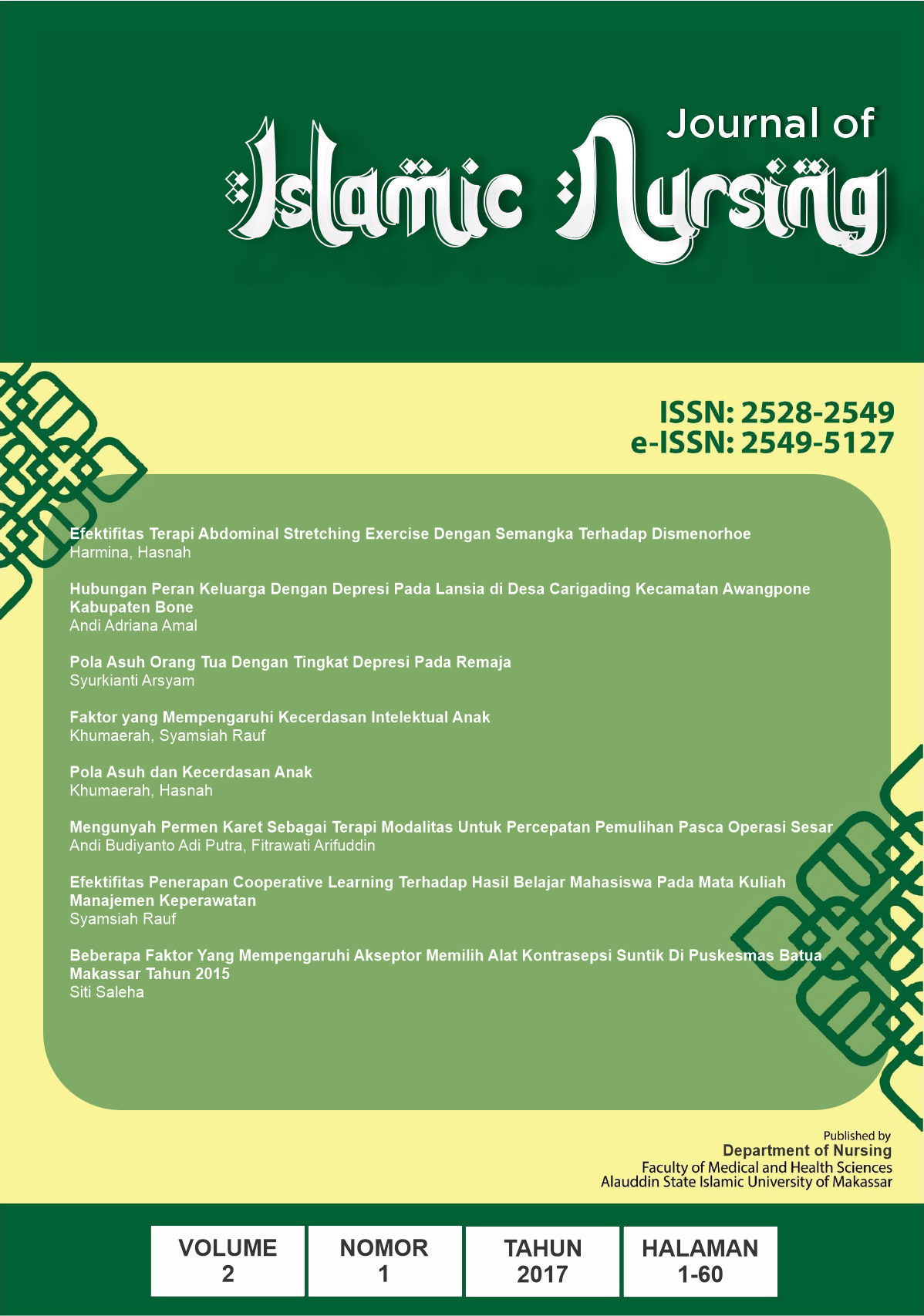MENGUNYAH PERMEN KARET SEBAGAI TERAPI MODALITAS UNTUK PERCEPATAN PEMULIHAN PASCA OPERASI SESAR
Abstract
Caesarean Section is the most common surgery leading to decrease bowel movement and brings gastrointestinal problems. Some studies explore the use of gum chewing in the hasten of gastrointestinal motility after cesarean section. This modality continues to be known as one of modality in solving gastrointestinal problem after abdominal surgery. This simple and easy intervention has shown big influence and benefit. However, in Indonesia remain unknown. The purpose of this reviews is to describe chewing gum and its mechanism in reducing gastrointestinal problems following caesarean section. This paper reviews articles cited from literature searching include ProQuest, EBSCO HOST, Science Direct, dan other searching engine Google. We identified 34 abstracts, after screening a total of 8 studies met the inclusion criteria with 5 RCTs and 3 systematic reviews. The result shows that this modality can fasten the recovery time and supports faster oral intake, it also can give effect on decreasing length of hospital stay and cost for its harmless, easy, benefit and inexpensive. In conclusion, the use of gum chewing after caesarean section has been demonstrated as modality to support the hasten of gastrointestinal motility after caesarean surgery.Downloads
References
Abd-El-Maeboud, K. H. I., Ibrahim, M. I., Shalaby, D. A. A., & Fikry, M. F. (2009). Gum chewing stimulates early return of bowel motility after caesarean section. BJOG: An International Journal of Obstetrics and Gynaecology, 116(10), 1334–1339. https://doi.org/10.1111/j.1471-0528.2009.02225.x
Bonaz, B., & Sinniger, V. (2016). Vagal tone : effects on sensitivity , motility , and inflammation, 28, 455–462. https://doi.org/10.1111/nmo.12817
Chuamor, K., & Jiraporn, T. (2014). Effectiveness of Standard Nursing Care with Gum Chewing to Reduce Bowel Ileus in Post-operative Gynecologic Patients: Randomized Controlled Trials. Siriraj Medical Journal, 66(number 2), 700–712. https://doi.org/10.1111/jbi.12236
Goudra, B. G., Singh, P. M., Carlin, A., Manjunath, A. K., Reihmer, J., Gouda, G. B., & Ginsberg, G. G. (2015). Effect of Gum Chewing on the Volume and pH of Gastric Contents: A Prospective Randomized Study. Digestive Diseases and Sciences, 60(4), 979–983. https://doi.org/10.1007/s10620-014-3404-z
Kehlet, H. (2008). Postoperative ileus--an update on preventive techniques. Nature Clinical Practice. Gastroenterology & Hepatology, 5(10), 552–558. https://doi.org/10.1038/ncpgasthep1230
Lauer, J. a, Betrán, A. P., Merialdi, M., & Wojdyla, D. (2010). Determinants of caesarean section rates in developed countries : supply , demand and opportunities for control. World Health Organization, 22.
Ledari, F. M., Barat, S., & Delavar, M. A. (2012). Chewing gums has stimulatory effects on bowel function in patients undergoing cesarean section: a randomized controlled trial. Bosnian Journal of Basic Medical Sciences / Udruženje Basičnih Mediciniskih Znanosti = Association of Basic Medical Sciences, 12(4), 265–268. Retrieved from http://www.ncbi.nlm.nih.gov/pubmed/23198943%5Cnhttp://www.pubmedcentral.nih.gov/articlerender.fcgi?artid=PMC4362503
Li, S., Liu, Y., Peng, Q., Xie, L., Wang, J., & Qin, X. (2013). Chewing gum reduces postoperative ileus following abdominal surgery: A meta-analysis of 17 randomized controlled trials. Journal of Gastroenterology and Hepatology, 28(7), 1122–1132. https://doi.org/10.1111/jgh.12206
Lorber, M. (2000). Results of simulated mastication suggest existence of a periodontogastric motility reflex. Canadian Journal of Physiology and Pharmacology, 78(1), 29–35. Retrieved from http://www.embase.com/search/results?subaction=viewrecord&from=export&id=L30097347%5Cnhttp://link.kib.ki.se/?sid=EMBASE&issn=00084212&id=doi:&atitle=Results+of+simulated+mastication+suggest+existence+of+a+periodontogastric+motility+reflex&stitle=Can.+J.+P
MacDorman, M. F., Menacker, F., & Declercq, E. (2008). Cesarean birth in the United states: Epidemiology, Trends, and outcomes. Journal Clinical Patology, 35, 293–303. https://doi.org/10.1016/j.clp.2008.03.007
Marwah, S., Singla, S., & Tinna, P. (2012). Role of gum chewing on the duration of postoperative ileus following ileostomy closure done for typhoid ileal perforation: A prospective randomized trial. Saudi Journal of Gastroenterology, 18(2), 111. https://doi.org/10.4103/1319-3767.93812
Mohsenzadeh Ledari, F., Barat, S., Delavar, M. A., Banihosini, S. Z., & Khafri, S. (2013). Chewing sugar-free gum reduces ileus after cesarean section in nulliparous women: a randomized clinical trial. Iranian Red Crescent Medical Journal, 15(4), 330–334. https://doi.org/10.5812/ircmj.6458
Slim, K. (2013). Oral sweet liquids 2hours before surgery, chewing-gum and coffee after surgery… What else! Journal of Visceral Surgery, 150(1), 1–2. https://doi.org/10.1016/j.jviscsurg.2013.01.003


